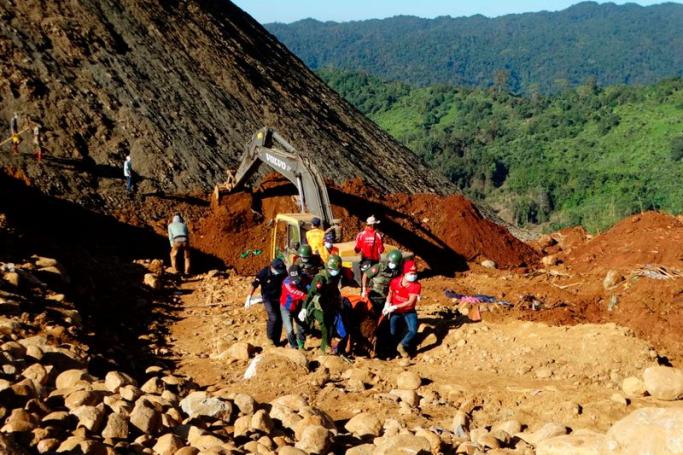Search teams said Tuesday they had abandoned hope of finding survivors from a landslide in north Myanmar's jade mining heartland which killed more than 100 people.
It is one of the deadliest incidents surrounding the billion-dollar jade trade that enriches a shadowy elite while destroying the local environment and social structure.
Scores of mainly itinerant prospectors sleeping in tents were buried when a towering mound of earth dumped by mining firms collapsed early Saturday at Hpakant in war-torn Kachin state, the hub of the jade industry.
Recovery teams including the army, police and local community organisations have pulled 113 bodies from the rubble. Only one man was found alive on Saturday but died soon after of his injuries.
Dashi Naw Lawn of the Kachin Network Development Foundation, which is helping the search, said no further survivors were expected.
"We are seeing only dead people," he told AFP, adding that recovery operations continued at the site Tuesday with possibly dozens of people still missing.
Authorities could not confirm the number of people who were searching for jade at the time of the landslide.
But the state-backed Global New Light of Myanmar Tuesday quoted local officials as estimating another 30 bodies could still be buried.
It said the area had been designated "high risk" by authorities, who now plan to relocate a further 70 miner huts built in the shadow of other waste mountains.
- 'Stone of heaven' –
Myanmar is the world's main source of the finest jadeite, a near-translucent green stone that is highly sought after in neighbouring China, where demand is surging as incomes rise.
The highest quality Myanmar jade is known by its Chinese admirers as "stone of heaven" or "imperial jade" because it was historically a preserve of the elite and is thought to possess a wealth of virtuous properties, including bringing its owner good health.
Jade values depend on the quality and craftsmanship of each individual piece, with raw chunks of the precious stone imported to China and Hong Kong where they are carved into jewellery and trinkets that can fetch anything between a few dollars and hundreds of thousands.
Mining firms linked to former junta figures, the military elite and cronies are thought to be raking in huge profits from the trade, which has dramatically expanded in recent years despite reforms under a new quasi-civilian regime.
Advocacy group Global Witness estimates the jade industry was worth some $31 billion in 2014 alone -- a sum far exceeding the $3.4 billion official sales as most of the best-quality jade is thought to be smuggled directly into China.
As mining firms creep closer to villages in their hunt for the precious stone, residents complain of abuses including land-grabbing and strong-arm tactics from local security forces.
The area, once thickly covered in forest, is now ringed with naked hills and pocked by huge craters as large-scale mining transforms the landscape.
Access to Hpakant is barred to nearly all foreigners, while the road into the area is an almost impassable mud track lined with army checkpoints and the huge orange trucks of the jade firms.
But it is a magnet to impoverished migrants from across Myanmar who flock to the area in the hope of striking it rich.
They often fall victim to the heroin and methamphetamine that floods the area, a by-product of Myanmar's massive narcotics trade centred in neighbouring Shan state.
© AFP
You are viewing the old site.
Please update your bookmark to https://eng.mizzima.com.
Mizzima Weekly Magazine Issue...
14 December 2023
Spring Revolution Daily News f...
13 December 2023
New UK Burma sanctions welcome...
13 December 2023
Spring Revolution Daily News f...
12 December 2023
Spring Revolution Daily News f...
11 December 2023
Spring Revolution Daily News f...
08 December 2023
Spring Revolution Daily News f...
07 December 2023
Diaspora journalists increasin...
07 December 2023
Drone attack in Sagaing’s Ayadaw kills two junta soldiers












